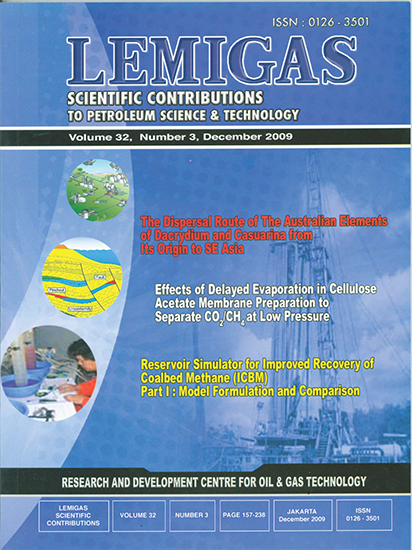Carbon Capture And Storage (Ccs) - Enhanced Oil Recovery (Eor): Global Potential In Indonesia
DOI:
https://doi.org/10.29017/SCOG.32.3.855Keywords:
Emission Mitigation, Climate Change, Carbon Dioxide Capture and Storage (CCS), Enhanced Oil Recovery (EOR)Abstract
Total global CO2 emissions from fossil-fuel will still increase in the next ten decades. These are attributed to the heavy reliance of human activities with fossil fuels. The uncontrolled CO2 emissions from combustion of fossil fuels cause the CO2 concentration alteration in the atmosphere. As the result, this phenomenon cause global warming and change the climate globally. In the future, CO2 emissions are predicted in range from 29 to 44 GtCO2/year in 2020. Therefore it is necessary to abate the CO2 Â missions to the level that would prevent dangerous anthropogenic interference to the global climate system. The growth of energy efficiency improvements, the switch to less-carbon intensive fuels and renewable resources employment is still low in the context CO2 emissions mitigation. Carbon Dioxide Capture and Storage (CCS) as a third option for these mitigation options might facilitate achieving CO2 Â missions stabilization goals. As a part of the commitment and participation on combating the global warming, Indonesia has signed the Kyoto Protocol in 1998 and ratified it in 2004 through Law No. 17/2004. On the other side, Indonesia oil production has been declining since in the last ten years but demand for this energy is still high. In this frame CCS-Enhanced Oil Recovery (EOR) by CO2 injection might answer the global warming challenges and alongside contribute to increase the oil production in the near future. This paper presents a preliminary study of CCS-EOR potential in Indonesia. A brief explanation of geological setting and reservoir screening for site selection also presented. Then some discussions about CCS-EOR global potential will be highlighted as well as the analysis. It is hoped that this study would provide a standard guideline for determining CCS- EOR potential in Indonesia.
References
Brioletty, L., Syahrial, E., and Tobing, E., 2007,
Peranan Teknologi Sekuestrasi CO2 Dalam
Menciptakan Mekanisme Pembangunan Bersih
di Indonesia: Proceeding of Society of Indonesian
Petroleum Engineer, 9th National Symposium.
Davison, J., Freund, P., and Smith, A., 2001, Putting
Carbon Back Into The Ground, IEA Greenhouse
Gas R&D Programme, 13-15.
European Carbon Dioxide Network (CO2 net),
, Capturing and Storing Carbon Dioxide:
Technical lessons learned, R&D and Technology
Exploitation For CO2 Sources, Transport, Geological
Storage.
Holloway, S., Chadwick, A., Lauriol, I. C., and
Arts, R., 2004, Best Practice Manual: Saline
Aquifer CO2 Storage Project, Appendix A Statoil
Research Center, 5-16.
IEA, 2004, Energy Technology Analysis: Prospects
For CO2 Capture And Storage, International
Energy Agency, 81-88.
Metz, B., Devidson, O., Coninck, H., Loos, M.,
and Meyer, L., 2005, IPCC Special Report: Carbon
Capture and Storage, 197-264.
Syahrial, E., 2007, Kajian Potensi Sekuestrasi Carbon
Dioxide Pada Lapangan Minyak Tua
Sangatta Kalimantan Timur, Diklat Fungsional
Peneliti Tingkat Pertama.
Syahrial, E., Brioletty, L., Saptono, F., and
Misfaroh, Z., 2007, Study of CO2 Sequestration
Potential for Storage and EOR: Proceedings Indonesian
Petroleum Association, 32th. Annual
Convention.
www.cenimar.com, 2008, Carbon Dioxide
Downloads
Issue
Section
License
Copyright (c) 1970 SCIENTIFIC CONTRIBUTIONS OIL AND GAS (SCOG)

This work is licensed under a Creative Commons Attribution 4.0 International License.
Authors are free to Share — copy and redistribute the material in any medium or format for any purpose, even commercially Adapt — remix, transform, and build upon the material for any purpose, even commercially.
The licensor cannot revoke these freedoms as long as you follow the license terms, under the following terms Attribution — You must give appropriate credit , provide a link to the license, and indicate if changes were made . You may do so in any reasonable manner, but not in any way that suggests the licensor endorses you or your use.
No additional restrictions — You may not apply legal terms or technological measures that legally restrict others from doing anything the license permits.














